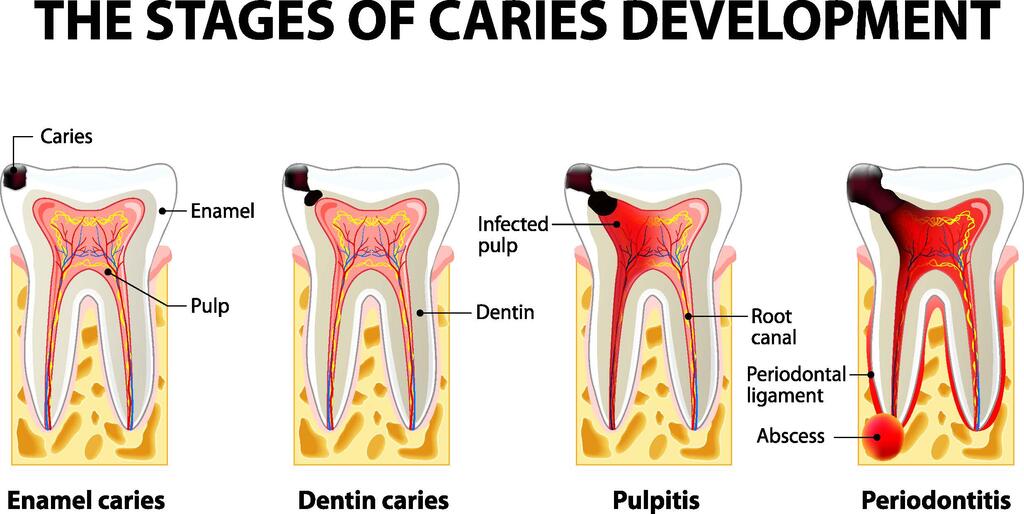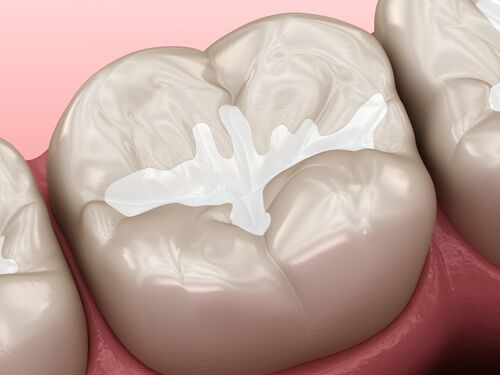Tooth decay is a major oral health problem in most industrialised countries, affecting 60–90% of schoolchildren and the vast majority of adults. By the age of 15, 75% of Irish children suffer from tooth decay.
 Most people know that ‘sugar is bad for their teeth’, however the process of tooth decay is not generally well understood.
Most people know that ‘sugar is bad for their teeth’, however the process of tooth decay is not generally well understood.
Tooth decay is caused by the action of acids on the enamel surface produced when sugars (mainly sucrose) in foods or drinks react with bacteria present in the dental biofilm (plaque) on the tooth surface. The acid produced leads to a loss of calcium and phosphate from the enamel; this process is called demineralisation. Saliva acts to dilute and neutralise the acid which causes demineralisation and is an important natural defence against caries.
Fortunately, the mouth has its own in-built defence mechanism and after about 20 minutes, if no further sugar is taken, the acid begins to neutralise and the tooth surface will be restored to normal by the buffering effect of the saliva. The teeth can withstand three or four of these ‘acid attacks’ each day without too much damage being done. The problem arises when sugar containing foods/drinks are taken more often than four times a day! They are then unable to restore the natural balance between attacks and tooth decay is the result.
Tooth decay, even in children who do not yet have their permanent teeth, can have serious and lasting complications such as pain, tooth abscess, tooth loss, broken teeth, chewing problems and serious infection. The decay can also attack the roots of teeth should they become exposed by gum recession. This is more common in older adults.
Prevention of Dental Caries (decay)
The prevention of dental caries can be approached in three ways:
Use fluorides, and brush teeth twice daily which will help make the tooth enamel more resistant to decay.
Apply pit and fissures seallants - dental procedure.
Reduce Frequent Consumption of Sugars
 Frequent consumption of sugars is associated with tooth decay. Dietary advice recommends limiting the frequency of sugar intake. Sugar consumption remains a moderate risk factor for tooth decay even when populations have adequate exposure to fluoride. Exposure to fluoride coupled with a reduction of sugar intake has an additive effect on the reduction of tooth decay.
Frequent consumption of sugars is associated with tooth decay. Dietary advice recommends limiting the frequency of sugar intake. Sugar consumption remains a moderate risk factor for tooth decay even when populations have adequate exposure to fluoride. Exposure to fluoride coupled with a reduction of sugar intake has an additive effect on the reduction of tooth decay.
Becoming aware of which food and drinks contain “free sugars” (i.e., sugars which have been added to food plus sugars naturally present in honey, fruit juices and syrup) can help you reduce the frequency of their intake – especially between meals. The intake of sugar between meals increases the periods of time that plaque pH dips below the critical level of 5.5. When plaque pH is lower than 5.5, remineralisation occurs. Subjecting teeth to frequent bouts of demineralisation allows less time for their remineralisation; thus, teeth become more susceptible to decay. Further advice on nutrition and oral health: https://www.dentalhealth.ie/dentalhealth/nutrition.html
Pit and Fissure Sealants
 Among children, tooth decay occurs most commonly on the pit and fissure surfaces of back teeth. Pit and fissure sealants are a safe and effective way to prevent dental caries on these vulnerable surfaces, and they are recommended for high caries risk children and should be applied as soon as the back teeth are sufficiently erupted to allow sealing. Pit and fissure sealants may also be used in adults. Sealants must be applied by a dental professional, i.e., a dentist or dental hygienist.
Among children, tooth decay occurs most commonly on the pit and fissure surfaces of back teeth. Pit and fissure sealants are a safe and effective way to prevent dental caries on these vulnerable surfaces, and they are recommended for high caries risk children and should be applied as soon as the back teeth are sufficiently erupted to allow sealing. Pit and fissure sealants may also be used in adults. Sealants must be applied by a dental professional, i.e., a dentist or dental hygienist.
Pit and fissure sealants create a thin barrier preventing the access of plaque and plaque acids to the enamel surface. However, sealants are only effective on the biting surfaces of teeth and should be seen as only one part of a caries prevention programme which includes promotion of healthy eating and, for children over age 2 years, twice daily use of fluoride toothpaste containing at least 1,000 ppm F.
Fillings
The main treatment option for a tooth cavity is to drill out the decay and put in a filling to replace your missing enamel. Fillings are made from various materials (e.g., composite resins, amalgam, porcelain). Extensive tooth decay may necessitate a crown, root canal treatment or even extraction of the tooth.
During the 1990s, there was strong controversy regarding the possible damage to health from the use of mercury amalgam material to fill cavities caused by decay. Extensive research has shown that there is no valid scientific evidence to support a link between the presence of amalgam fillings in the mouth and systemic disease. A safety review (2008) conducted by the Scientific Committee on Emerging and Newly Identified Health Risks (SCENIHR) of the European Commission confirmed that both mercury amalgam and alternative filling materials such as composite resins, glass ionomer cements, ceramics and gold alloys are safe to use for restoring teeth. Nonetheless the Minamata Convention on Mercury (2013) includes agreement to a global phase-down of the use of dental fillings containing mercury amalgam taking into account the domestic circumstances of individual countries. The need to ensure environmentally sound storage and final disposal of the product was also agreed.